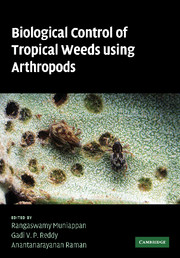Book contents
- Frontmatter
- Contents
- List of contributors
- Acknowledgments
- 1 Biological control of weeds in the tropics and sustainability
- 2 Acacia nilotica ssp. indica (L.) Willd. ex Del. (Mimosaceae)
- 3 Australian Acacia species (Mimosaceae) in South Africa
- 4 Ageratina adenophora (Sprengel) King and Robinson (Asteraceae)
- 5 Azolla filiculoides Lamarck (Azollaceae)
- 6 Cabomba caroliniana Gray (Cabombaceae)
- 7 Invasive cactus species (Cactaceae)
- 8 Chromolaena odorata (L.) King and Robinson (Asteraceae)
- 9 Clidemia hirta (L.) D. Don (Melastomataceae)
- 10 Coccinia grandis (L.) Voigt (Cucurbitaceae)
- 11 Eichhornia crassipes (Mart.) Solms–Laub. (Pontederiaceae)
- 12 Lantana camara Linn. (Verbenaceae)
- 13 Mimosa diplotricha C. Wright ex Sauvalle (Mimosaceae)
- 14 Mimosa pigra L. (Leguminosae)
- 15 Parthenium hysterophorus L. (Asteraceae)
- 16 Passiflora mollissima (HBK) Bailey (Passifloraceae)
- 17 Pistia stratiotes L. (Araceae)
- 18 Prosopis species (Leguminosae)
- 19 Salvinia molesta D. S. Mitchell (Salviniaceae)
- 20 Solanum mauritianum Scopoli (Solanaceae)
- 21 Application of natural antagonists including arthropods to resist weedy Striga (Oranbanchaceae) in tropical agroecosystems
- 22 Biological control of weeds in India
- 23 The role of International Institute of Tropical Agriculture in biological control of weeds
- 24 The role of Secretariat of the Pacific Community in the biological control of weeds in the Pacific Islands region – past, present, and future activities
- Index
17 - Pistia stratiotes L. (Araceae)
Published online by Cambridge University Press: 04 August 2010
- Frontmatter
- Contents
- List of contributors
- Acknowledgments
- 1 Biological control of weeds in the tropics and sustainability
- 2 Acacia nilotica ssp. indica (L.) Willd. ex Del. (Mimosaceae)
- 3 Australian Acacia species (Mimosaceae) in South Africa
- 4 Ageratina adenophora (Sprengel) King and Robinson (Asteraceae)
- 5 Azolla filiculoides Lamarck (Azollaceae)
- 6 Cabomba caroliniana Gray (Cabombaceae)
- 7 Invasive cactus species (Cactaceae)
- 8 Chromolaena odorata (L.) King and Robinson (Asteraceae)
- 9 Clidemia hirta (L.) D. Don (Melastomataceae)
- 10 Coccinia grandis (L.) Voigt (Cucurbitaceae)
- 11 Eichhornia crassipes (Mart.) Solms–Laub. (Pontederiaceae)
- 12 Lantana camara Linn. (Verbenaceae)
- 13 Mimosa diplotricha C. Wright ex Sauvalle (Mimosaceae)
- 14 Mimosa pigra L. (Leguminosae)
- 15 Parthenium hysterophorus L. (Asteraceae)
- 16 Passiflora mollissima (HBK) Bailey (Passifloraceae)
- 17 Pistia stratiotes L. (Araceae)
- 18 Prosopis species (Leguminosae)
- 19 Salvinia molesta D. S. Mitchell (Salviniaceae)
- 20 Solanum mauritianum Scopoli (Solanaceae)
- 21 Application of natural antagonists including arthropods to resist weedy Striga (Oranbanchaceae) in tropical agroecosystems
- 22 Biological control of weeds in India
- 23 The role of International Institute of Tropical Agriculture in biological control of weeds
- 24 The role of Secretariat of the Pacific Community in the biological control of weeds in the Pacific Islands region – past, present, and future activities
- Index
Summary
Taxonomy
Earliest descriptions of Pistia stratiotes L. (Araceae) were by the ancient Egyptians and by the Greek philosophers Dioscorides and Theophrastus. This plant has also been mentioned by Plinius (Stoddard, 1989). According to Bogner and Nicolson (1991) P. stratiotes is the solitary member of the subfamily Pistioidea in Araceae. However, USDA (2008) places it in the subfamily Aroideae along with the numerous other genera. The many synonyms and obsolete subspecific names (Plantatlas, 2006) attest to the variability of this taxonomically isolated species, which is the only free-floating aroid. The plant is known as water lettuce; other common names are available in Randall (2002).
Description
Pistia consists of a rosette of obovate to spatulate, velvety, light-green leaves (up to 40 cm long in African and American clones) (Fig. 17.1a, b), covered by short hairs, which trap air bubbles and thus enable buoyancy. The underside of leaves is densely hairy and almost white, with longitudinal ribs with embedded veins. The long feathery roots hang freely in the water. A clonal plant forms small colonies through stolons. Inflorescences are inconspicuous (7–12 × 5 mm) with short peduncles in the center of the rosette, growing on a stem. The spadix, enclosed in a whitish spathe, is pale green, hairy outside and glabrous inside. The spathe generally shows a constriction between the groups of male and the female flowers. The spathe below the constriction opens first in the morning hours to expose the wet stigma, whereas the male flowers remain enclosed.
- Type
- Chapter
- Information
- Biological Control of Tropical Weeds Using Arthropods , pp. 332 - 352Publisher: Cambridge University PressPrint publication year: 2009
- 33
- Cited by



